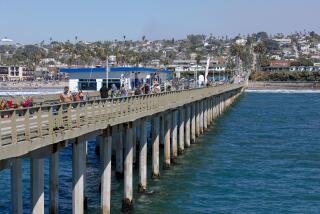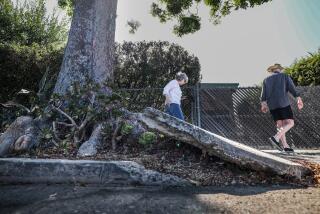Cliff Walk Crumbling; City Eyes Costly Fixes
- Share via
NEWPORT, R.I. — The historic trail that hugs Newport’s craggy coastline offers views of crashing waves on one side and of some of the city’s grandest estates on the other.
But years of neglect and storm damage have chipped away at the terrain, making portions of the 3.5-mile Cliff Walk perilous for pedestrians. Now, a city commission is trying to raise as much as $20 million to save the popular trail that is visited by 250,000 tourists a year.
“There are whole areas of the walk that are practically impassable, with tremendous erosion problems,” said Laurence Cutler, head of the newly revived Cliff Walk commission.
The city, state and federal government have long trumpeted the trail’s historic and environmental significance, but no one has taken responsibility for the pathway since it is unclear who owns it.
Parts of the trail predate Colonial times, when the earliest settlers needed access to the ocean. More was built in the late 1800s, as the area grew in popularity as a retreat for the Vanderbilts, Astors and others among the nation’s wealthiest families. Several mansions on famed Bellevue Avenue overlook the trail.
“It is private property through which a public walk goes,” Cutler said. “It’s extraordinarily unique.”
The government has paid to repair some storm damage over the years, and in 1975, the walk was designated a National Recreation Trail. But there has been little ongoing maintenance, aside from some individual efforts, such as volunteers who collect trash.
Some sections are crumbling. Another often floods. A tunnel through one part is pitch dark and damp.
Since 1987, three people have died after falling off the walk, and several others have been seriously hurt, including a New York man who fell 14 feet and became wedged between two rocks last month.
A lawsuit over a 1991 fatal accident convinced Mayor Richard Sardella to revive the long-dormant commission. He asked Cutler, a former Harvard University professor of architecture and urban design, to lead the group.
The family of Michael Cain, a college student, sued over his fatal fall, saying the city, state and a university with property along the path were responsible. Cain’s family lost, but a dissent by a state Supreme Court justice sent a warning.
“The record . . . is replete with evidence that every defendant, for more than a decade before Cain’s tragic death, had knowledge of the extremely dangerous conditions on Cliff Walk, yet did nothing,” the justice wrote. “I do not believe that one can hold out an implicit invitation to visit a tourist attraction . . . then seek to escape liability to those who have accepted the invitation and are injured or killed.”
Cutler envisions improvements, such as building separate trails: one geared to tourists, one to hikers and one to people interested in the walk’s history. Signs telling people where to enter and exit, along with more trash barrels and portable toilets would also make the walk more tourist-friendly, Cutler said.
But before any restoration can begin, the city must resolve local differences over what the walk should be. There is also the challenge of figuring out how to pay for such a project; last month, Rep. Patrick Kennedy, D-R.I., toured the walk to highlight the need for federal funding for repairs.
Many property owners along the trail who have complained about littering and vandalism want the trail left as is, fearing an upgrade could bring more tourists. But city leaders believe these concerns can be addressed, while also solving the broader public safety issue.
Without some action, Cutler feels the pathway he describes as the city’s “jewel” could be lost.
Lara Cogliano and fiance Matthew Marra from New York City, were drawn to the walk by a relative of Cogliano’s who recently visited.
“Whenever you read about Newport, it always mentions Cliff Walk,” Cogliano said. “It has a spectacular view of the ocean and an ocean view of the mansions.”
Don Hammer, chairman of the city Planning Board, volunteers collecting trash on Cliff Walk and hopes repairs can be done soon.
“The walk is one of the things that makes Newport what it is,” Hammer said.
More to Read
Sign up for The Wild
We’ll help you find the best places to hike, bike and run, as well as the perfect silent spots for meditation and yoga.
You may occasionally receive promotional content from the Los Angeles Times.






